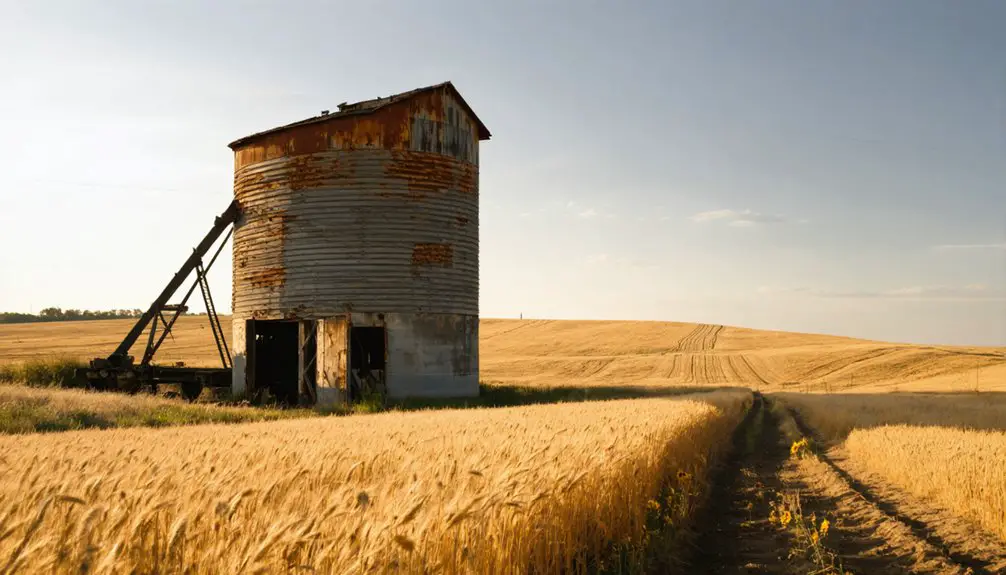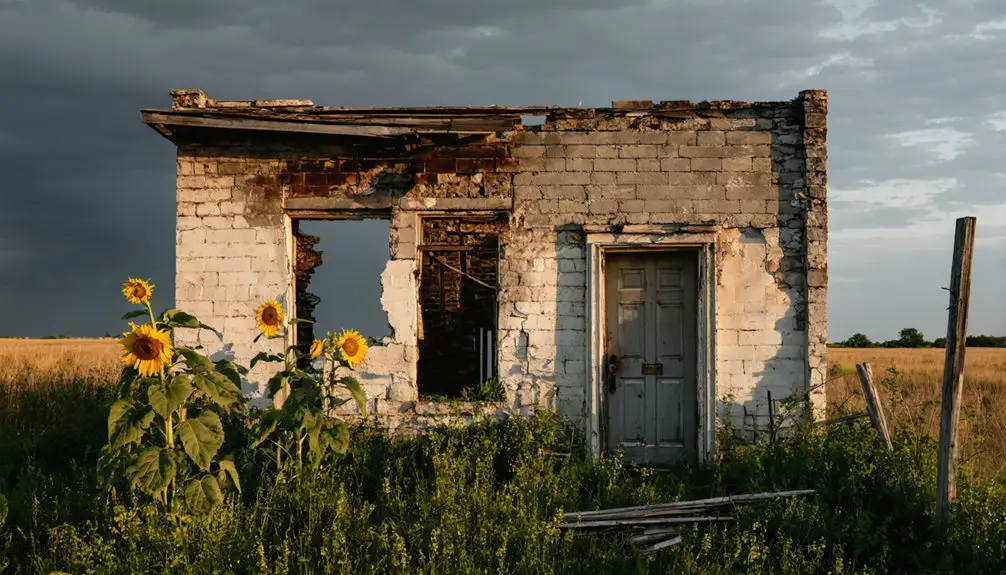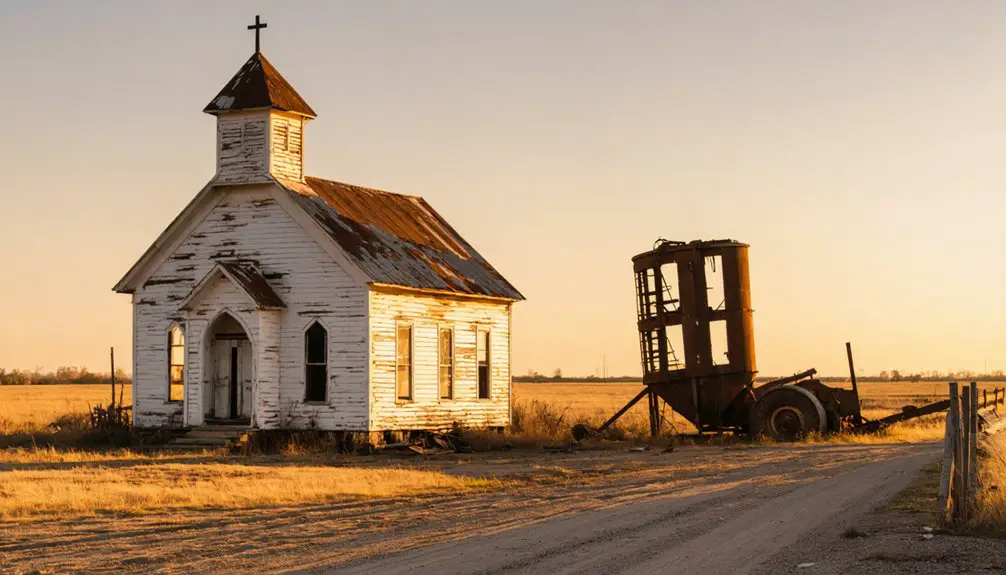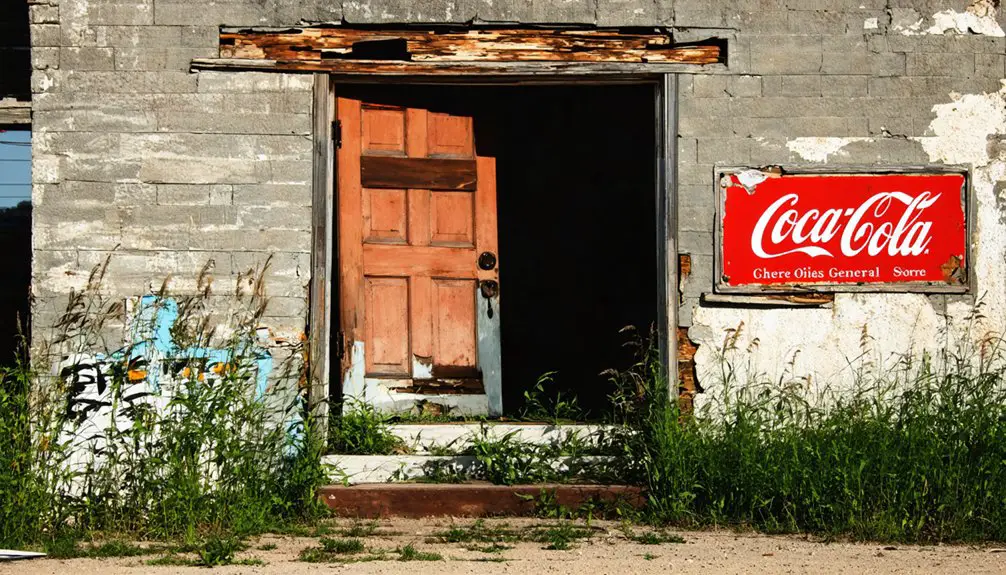You’ll find Wildman’s remnants 15.5 miles from Hobart, Oklahoma, where over 500 residents once sought their fortunes in 1900. This lawless boomtown emerged after the federal government opened Wichita Mountains to miners, attracting prospectors, gamblers, and bandits to its makeshift saloons and crude mine shafts. Though thousands of claims were filed between 1901-1910, the gold rush dreams faded, leaving behind a legacy of shootouts, mining accidents, and eventual transformation into agricultural land.
Key Takeaways
- Wildman emerged as a mining boomtown in 1900 when the federal government opened Wichita Mountains to prospectors seeking gold and minerals.
- The town rapidly grew to over 500 residents, featuring saloons, gambling establishments, and makeshift housing for miners and their families.
- Despite numerous mining claims and the presence of the Gold Belle Mining Company, the town’s mines yielded minimal gold returns.
- Lawlessness characterized the settlement, with frequent shootouts and brawls occurring in saloons due to minimal law enforcement presence.
- The town eventually transitioned from mining to agriculture, with abandoned mines and claims becoming farmland and grazing areas.
The Birth of a Mining Frontier Town
When the federal government opened the Wichita Mountains to miners in fall 1900, it set off a chain of events that would give birth to Wildman, Oklahoma. You’d have witnessed a surge of prospectors rushing to stake their claims on land that was previously part of Kiowa-Comanche-Apache territory, keen to exploit the area’s rumored mineral wealth.
As mining claims multiplied across the northern and western slopes, frontier settlement quickly took shape. The miners relied heavily on company store credit, often falling into debt while pursuing their dreams of striking it rich. You would’ve found numerous tunnels and shafts being dug into the granite hills near Nest Egg Mountain, where assays suggested rich deposits of gold, silver, lead, copper, and platinum. Located 15.5 miles from Hobart, the town emerged as a wild west outpost attracting miners, gamblers, and bandits alike.
The Gold Bells Mine emerged as one of the area’s most notable operations, marking Wildman’s transformation from restricted Indian land to a bustling mining frontier.
Life in the Wild West Boomtown
You’d find yourself among the boisterous crowds at Wildman’s saloons, where miners fresh from their claims swapped tales of gold strikes while gamblers and con men worked the room.
The mining camp’s lawless nature became evident in the frequent brawls and shootouts, with the nearest marshal’s office being two days’ ride away. Local farmers and ranchers established themselves near the settlement to provide food resources for the growing population. The town’s explosive growth attracted merchants, families, and service providers seeking opportunities in the bustling community.
Gold fever gripped the settlement as prospectors rushed to stake their claims in the nearby hills, transforming peaceful valleys into a maze of hastily dug mineshafts and ramshackle shelters.
Daily Saloon Culture
Inside the rough-hewn walls of Wildman’s saloons, the heart of frontier social life pulsed day and night. You’d find settlers, miners, and travelers gathered around gaming tables, testing their luck at poker and faro while sharing tales of the day’s trials. These gatherings offered much-needed refuge from isolation for those living on the lonely frontier.
Saloon etiquette meant respecting the unspoken rules of the house, where your word was your bond and gambling strategies could make or break your fortune. In the early days, many saloons were simply makeshift canvas structures until the town grew.
These weren’t just drinking establishments – they served as your all-in-one community hub. You could get a hot meal, rent a room, catch up on local news, or strike a business deal over whiskey.
The barkeep knew everyone’s story and kept the peace, while music and laughter filled the air. After grueling work in the mines or fields, you’d find comfort in the warmth of these round-the-clock gathering spots.
Lawless Mining Camp Life
As mining fever gripped Wildman in the early 1900s, the boomtown’s population swelled to over 500 residents who carved out precarious lives in makeshift tents and crude shelters beneath the granite hills.
The Tri-State Ore Producers formed strict guidelines for mining operations by 1924.
You’d find families, children, and even pets braving the harsh conditions alongside the miners who ventured deep into unstable tunnels searching for gold, silver, and copper.
Without formal law enforcement, you’d need to stay vigilant against prowlers and outlaws who frequently targeted the camp.
Mining accidents claimed lives regularly due to crude technology and lack of oversight. The isolation made getting medical help nearly impossible.
Early permit systems established by the Choctaw Nation failed to effectively regulate the influx of non-Native miners and their operations.
You’d witness frequent brawls, gambling, and occasional vigilante justice as miners defended their claims and property.
The rugged terrain that once belonged to the Osage provided perfect cover for those seeking to avoid the law.
Gold Fever Takes Hold
The legend of Spanish gold sparked Wildman’s explosive growth in 1900, drawing prospectors to the rugged Wichita Mountains where abandoned mine shafts dating back to 1765 fueled dreams of untold riches.
You’d find yourself among 500 settlers who transformed this frontier outpost into a bustling gold mining community, complete with saloons, gambling houses, and blacksmith shops.
The Gold Belle Mining and Milling Company led the economic speculation, selling 270,000 shares and building a 50-ton cyanide mill.
You could’ve staked one of the 2,000 claims filed between 1901 and 1910, joining the frenzy as prospectors dug shafts up to 200 feet deep around Nest Egg Mountain.
U.S. Army and Indian police struggled to maintain order as prospectors flooded the Kiowa-Comanche-Apache Reservation.
Ancient oak trees and mysterious stone markers left by Spanish miners only intensified the fever, though substantial gold proved elusive.
Located in Kiowa County, the remnants of this once-thriving boomtown stand as a testament to Oklahoma’s gold rush era.
Gold Rush Dreams and Economic Reality
When Spanish explorers first discovered traces of gold in the Wichita Mountains around 1765, they sparked a series of mining rushes that would culminate in Wildman’s dramatic boom period.
You’ll find that despite optimistic newspaper headlines proclaiming “Gold in them thar hills,” the economic reality painted a stark contrast to these golden dreams.
While over 2,000 mining claims flooded the area between 1901 and 1910, the actual gold yields proved disappointingly minimal.
Despite the surge of thousands flocking to stake their claims, the Wichita Mountains yielded little more than broken dreams.
The Gold Belle Mining and Milling Company exemplified this economic disparity perfectly.
Though they built an impressive 50-ton cyanide mill and sold 270,000 shares at $1 each, they never processed a single ounce of ore.
Instead, the owners “salted” the mine with gold dust, artificially inflating stock prices in a scheme that epitomized the gold rush’s false promises.
Saloons, Gambling, and Lawlessness

Life in Wildman revolved around its numerous saloons, which dominated the townscape and served as bustling social hubs for miners, gamblers, and drifters seeking escape from their harsh realities.
The saloon architecture reflected the town’s raw character, with basic wooden structures housing gambling tables where fortunes changed hands nightly. You’d find these establishments teeming with “unscrupulous gamblers” and bandits mingling freely with working miners.
The gambling culture thrived without interference from law enforcement, as Wildman embodied the spirit of the wild west with its frequent shootouts and violent confrontations.
The town’s economy centered heavily on these venues of vice, where deals were struck, disputes settled, and news shared. Like its contemporary Beer City, Wildman’s lawless atmosphere attracted those looking to operate beyond society’s constraints.
The Legacy of the Boothill Cemetery
As rowdy saloons and gambling halls defined Wildman’s living hours, Boothill Cemetery became its eternal resting ground in 1878, mirroring its Arizona namesake’s establishment.
You’ll find roughly 250 graves reflecting the remarkable Boothill diversity – from Chinese immigrants and Jewish pioneers to cowboys and outlaws, all sharing the same hallowed ground.
The grave epitaphs tell raw frontier tales, like Lester Moore’s famous marker: “four slugs from a .44, no less, no more.”
You’ll discover George Johnson’s tragic story: “Hanged by mistake in 1882. He was right, we were wrong.”
While the cemetery closed for general burials by 1883, it continued accepting society’s outcasts until 1953.
Today, weathered wooden markers and stark inscriptions preserve the authentic spirit of Oklahoma’s untamed frontier days.
From Mining Camp to Agricultural Land

If you’d visited Wildman in 1900, you’d have found a bustling mining camp with rough-hewn tunnels and shafts dotting Nest Egg Mountain near the headwaters of Otter Creek.
The abandoned mining operations gradually gave way to agricultural development as settlers recognized the potential of the land around Otter Creek for farming and ranching.
The change from mining to agriculture marked a significant shift in land use, as former prospectors’ claims and mining scars became integrated into emerging farmland and cattle grazing areas.
Mining Beginnings Shape Land
When the federal government opened the Wichita Mountains area to miners in fall 1900, Wildman, Oklahoma quickly emerged as a bustling mining camp focused on lead and zinc extraction.
You’d have found a rough-and-tumble atmosphere where mining technology shaped both the physical landscape and community structure. The town’s first diggings reportedly started at the graveyard, while cyanide ore mills and assayer offices sprang up to support the mining operations.
The camp’s infrastructure grew rapidly, with multi-purpose buildings housing groceries, hardware stores, and restaurants.
You could’ve visited numerous saloons and gambling venues that outnumbered other businesses, reflecting the wild spirit of the mining frontier. A post office and local newspaper, the Otter Creek Miner, served the transient population of miners, gamblers, and prospectors who shaped this dynamic settlement.
Rough Terrain Becomes Farmland
The rugged granite hills surrounding Wildman presented formidable challenges for early farmers who sought to transform the mining-scarred landscape into agricultural land.
You’ll find evidence of their determination in the terraced slopes they carved into Nest Egg Mountain and the ingenious irrigation channels they dug from Otter Creek.
Through intensive soil reclamation efforts, they sealed abandoned mine shafts, cleared mining debris, and enriched thin topsoil with essential nutrients.
Their crop adaptation strategies focused on hardy varieties that could thrive in rocky terrain, while livestock grazing made use of steeper areas.
They’ll never forget how the community banded together, sharing equipment and labor to overcome the land’s resistance.
Former mining roads became farm-to-market routes, and water management systems turned this once-industrial zone into productive farmland.
Transformation Through Time
Mining operations that once dominated Wildman’s landscape gradually gave way to agricultural development between 1900 and 1920, marking a significant transformation in the area’s economic foundation.
This cultural evolution reflected broader changes across Oklahoma’s mining regions, where you’ll find evidence of economic adaptation from mineral extraction to farming.
- Former mining camps that housed 500+ residents transformed into cleared agricultural plots
- Land once riddled with tunnels and shafts required extensive stabilization for farming use
- Complex mineral rights and Native American allotments shifted to agricultural leases
- Mining infrastructure gave way to crop fields and livestock grazing areas
You can still trace this transformation through remaining hand-etched claim markers and old tunnel remnants, while cattle now graze where prospectors once searched for gold near Nest Egg Mountain and Otter Creek.
Frequently Asked Questions
Were Any Famous Outlaws or Gunfighters Known to Visit Wildman?
Like a dusty legend lost to time, you won’t find concrete evidence of famous outlaws or gunfighter tales in Wildman’s history, despite its reputation for harboring nameless bandits and rough characters.
What Happened to the Residents After the Town Was Abandoned?
You’ll find most residents moved to nearby towns like Hobart, while others chased mining opportunities elsewhere. Life after abandonment led to widespread community displacement, with some folks shifting into farming or ranching work.
How Much Gold Was Actually Found in the Wildman Mines?
As hard as nails treasure hunters have tried, you won’t find reliable records of gold mining yields from Wildman mines. Historical documents don’t show any significant amounts extracted.
Did Any Original Artifacts From Wildman Survive to the Present Day?
You’ll find mining tunnels, shafts, and claim markers have survived, though they’re deteriorating. Original artifacts linked to the caves, including personal belongings and mining equipment, exist but aren’t widely preserved.
Were There Any Documented Native American Conflicts During Wildman’s Existence?
While Native American treaties impacted the region, you won’t find specific records of frontier skirmishes at Wildman itself. The town emerged after major tribal conflicts had largely subsided in Indian Territory.
References
- http://okietreasurehunter.blogspot.com/2008/04/wildman-oklahoma-ghost-town.html
- https://en.wikipedia.org/wiki/List_of_ghost_towns_in_Oklahoma
- https://okmag.com/blog/a-ghostly-site/
- https://www.youtube.com/watch?v=xg8SpCG-wDg
- https://www.ghosttowns.com/states/ok/wildman.html
- https://npgallery.nps.gov/NRHP/GetAsset/NRHP/78002230_text
- https://www.okhistory.org/publications/enc/entry?entry=MI042
- https://ahgp.org/tag/gold-mining
- https://digital-desert.com/ghost-towns/boomtowns.html
- https://digital-desert.com/blog/boom-town-historical-context-and-characteristics/



